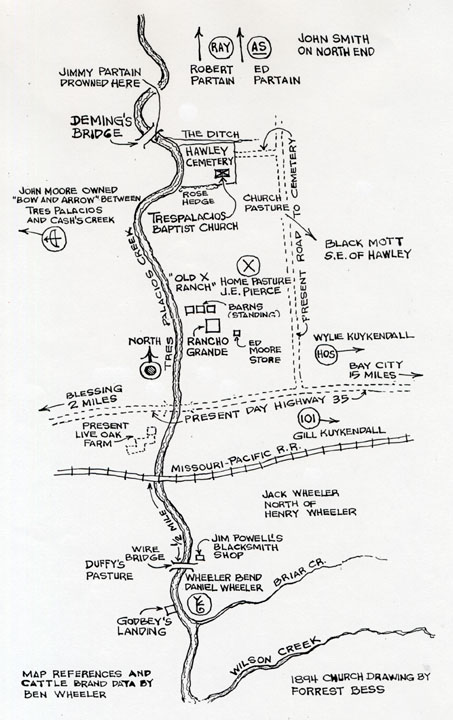|
Blessing & Deming's Bridge Information |
||
|
||
|
As early as 1850, the land on the Tres Palacios Creek that was to be known as Deming’s Bridge was a natural meeting place for the landowners who lived in the western part of Matagorda County. The lack of a crossing from the western bank of Tres Palacios to the eastern side was remedied on March 30, 1857, when Edwin A. Deming commissioned W. A. Dawdy to build a bridge that would accommodate foot traffic as well as horse and buggy passage. Increasingly, Deming’s Bridge became the socio-political hub (as well as the religious center) for the residents. In June, 1858, the post office of Deming’s Bridge was created, and Edwin Deming was named postmaster. He was succeeded by Martha M. McSparrow. In 1866 the post office was deactivated for a period of six years. The post office was recommissioned in 1872, and Joseph A. McIntire was named postmaster. Jonathan E. Pierce succeeded him in 1876; Henry E. Moore served from 1884 until 1902. In 1899 the name of the post office was changed to Hawley, Texas. James H. Logan was appointed postmaster of Hawley in May, 1902. In August, 1903, Hawley post office was moved to Blessing, which had grown up close to the railroad. The history of Deming’s Bridge is interwoven with the history of the careers of Abel Head Pierce and his brother Jonathan E. Pierce. Abel, later known to friend and foe as “Shanghai,” arrived in Texas from Rhode Island in 1853. A gangly nineteen-year-old youth, he went to work for the Grimes family on their cattle ranch on the Tres Palacios splitting rails. He roomed with Edwin Deming, beginning a lasting friendship. Abel and Jonathan Pierce formed their own cattle company called “Rancho Grande, “ with their head-quarters just south of Deming’s Bridge cemetery. Their letterhead, printed in Galveston read:
A. H. & J. E. Pierce As their fortunes progressed, Abel moved his head-quarters to the BU Ranch in Wharton County, but Jonathan remained at the X Ranch on the Tres Palacios, at Deming’s Bridge. After the post office was moved to Blessing, there was progressively less traffic over the old wooden bridge crossing the creek. Eventually the bridge was deemed unsafe even for foot traffic, and around 1930, it was removed.
|
||
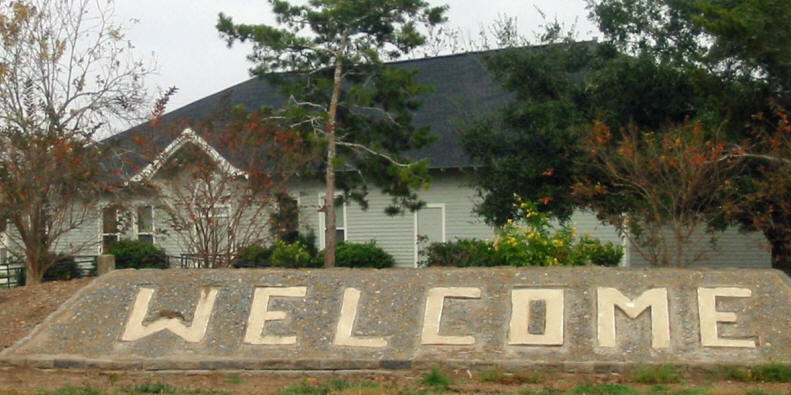 |
||
| |
||
|
The inception of the town of Blessing took place in the mind of Jonathan E. Pierce, owner of "Rancho Grande" on the east side of the Tres Palacios River near Deming's Bridge. Pierce owned cattle and land along the Tres Palacios as did other pioneer families. Surnames of some of the early settlers from about 1835 to 1900 were Keller, Wheeler, Rowles, Poole, Pybus, Lacey, Partain, McSparran, Yeamans, Downer, and Duffy. These families were served by the early communities of Deming's Bridge and Tres Palacios, each with a general store and post office. West ofthe Tres Palacios River was the Carancahua River. Some names of families living along this stream were: Rhodes, Logan, Fleury, Harris, Jordan, and Bolling. Traveling by water was the best means of transportation, as there were no roads. Ox teams and horses, however, hauled goods across the trackless prairies. Cattle were driven north to Dodge City and Topeka, Kansas, after the Civil War. These drives were long and treacherous, taking months to complete. In earlier days cattle were slaughtered for their hides and tallow, which were shipped East by water, rather than for beef.
In 1903,
after
Jonathan Pierce
and others gave
land
for a
right-of-way,
the
Galveston,
Harrisburg,
and San
Antonio Railway
(G
H&SA-
now the
Southern
Pacific) laid tracks west
from
Bay
City,
turning
south at
Midfield
and terminating at
Palacios.
Thereafter,
J.
E.
Pierce moved the
"Old
Moore
store"
building
from "Rancho
Grande"
west to
the railroad to become Blessing's
first store and
post office, with James H.
Logan
as postmaster. In 1905 the SLB&M
rail line was
built
crossing
the G H&SA to make Blessing
a
two railroad town.
Each
railroad had its own
station,
the G H&SA 's being
initially a
boxcar. The Blessing Hotel was built to cater to travelers and landseekers. It also served as the residence for J. E. Pierce and his son Abel B. Pierce, Sr. , after the "Rancho Grande" house burned in 1905. Sites for churches, a school, homes, and businesses were provided. C. H. Crandall was the first manager of the hotel.
In order to
direct
the selling of
lots,
the Hurd Land Company built an
office next
to the town square in September,
1907,
at the corner where a
two-story
brick
building now
stands.
A two-story brick
school
was erected. Early Blessing had a "Fair Day" each year which was well attended by families of the area. With farming and ranching- and later with oil leasing and production adding to the local income- the efforts of its founders were paying dividends, and the town of Blessing was on its way. Existing buildings which were moved to Blessing from Deming's Bridge or the Hawley area are: the Blessing Masonic Lodge Hall (originally built for the Tres Palacios Lodge and Baptist and Methodist church meetings; after being moved to Blessing it was used for early school classes and used as the Masonic meeting hall continuously to the present); and the business office at "Rancho Grande" (possibly occupied by "Hunky-Dory" Brown, the ranch bookkeeper mentioned by Charles Siringo in his book, A Texas Cowboy ), later was the A. B. Pierce office and the first site of Blessing State Bank when next to Southern Pacific Railway; in 1915 it was moved to the town square to become the Blessing Library (owned by Ladies' Blessing Library Association); it is now on the north side of the Community House, which was built in 1921 from plans by John Wheeler, architect, of St. Paul, Minnesota. A reverse move of interest: the present "privy" and storage building at Hawley Cemetery was formerly one of two outdoor facilities behind the two-story brick school building in Blessing, until the school was demolished. Some homes built in the early years and still standing in 1985 are: the A. B. Pierce and Pies Dawdy residences; two concrete masonry homes: the first belonged to Dr. Millard (who sold "Sayman's Soap" around the area from a horse and buggy), later occupied by a Mrs. Barlow, and now belonging to A. E. Kirby; the second was Tom Horne's home, now owned by A. M. (Bert) & Ola M. Schulte Logan. Other homes still in existence are the John Roach home which later became the Whites' and is now the home of Jerome & lola Pesak; C. E. Duller's home is now owned by A. J. & Elizabeth Pesak; Si Harter's home now belongs to the Bill Holzapfel family; A. O. Yeager's home became Mrs. Elmer Cornett's; the George Woodruff dwelling became the home of Louis Cornelius and is owned now by J. H. Ellis; and Mrs. Pete Hamelink's home is now the property of the King family. Business structures still in existence are the brick Blessing State Bank building, now housing the offices of Lee M. Pierce and the Matagorda County Water District No.5; SLB&M ("Mopac") station, now moved to the west side of town square and owned by Mrs. Arthur Matthes or E. B. Bell and rented to a cable television company; Blessing Warehouse & Elevator Company, sack rice storage building at intersection of railroads which is now a part of Rice Belt Warehouse, Inc. complex; the two-story brick "Logan Building," which formerly contained offices and a town recreation hall on the top floor with drug, dry goods, and grocery stores below, is now Myrtle's Lounge on the ground floor with apartments above, owned by E. B. Bell; the H. H. Lindner Garage (later the Landin Garage) building is now owned by the B. W. Trull family; William "Billy" Lindner Garage- the original owner reportedly stocked and sold coffins there; a panoramic photo of Blessing in 1912 was taken from its roof- is now a feed store and the office of Dr. Jim Davant, veterinarian; the Methodist and Presbyterian church building, known now as the Brethren Church (with original bell tower removed); and the Blessing Hotel building which is now the Hotel and Coffee Shop. The surrounding agricultural area had changed from raising cattle to raising cotton, sugar cane, corn, rice, and the like. Later, the cotton crops succumbed to the boll weevil, and the cotton gin ceased operation. The depression saw the demise of the Blessing Bank and hard times for all residents. The newspaper and its building had vanished many years before. For several years until World War II, Blessing was home of the "Gulf Coast Field Trials" competition for bird dogs, promoted by the local Anderson Kennels. With the coming of concrete highways and the upsurge of truck hauling, the Southern Pacific Railway no longer routes trains through Blessing; the Missouri Pacific trains no longer stop; and both depots have been removed. Avenue B (now FM 616), however, has become a major east-west artery for truck and tourist traffic along the coastal route to the Rio Grande Valley with considerable benefit to the Blessing Hotel and Coffee Shop as well as to other commercial establishments. After World War II, the county water district bought the water system from Mrs. A. B. Pierce, Sr., and added a town sewage disposal system. The arrival of electric and natural gas utilities has also made life easier in Blessing. Nearby exploration and the development of oil and natural gas production- starting about 1940 with Texaco's recycling plant- the construction of Alcoa's aluminum plant thirty miles away, and the continuing construction of the STNP power plant some seventeen miles away have combined to produce a surge in the town's population, accompanied by the addition of numerous mobile homes and trailers, as well as some attractive permanent residences. Blessing remains unincorporated, thus no city limits exist and its population is indeterminate. The possibly temporary increase in population is producing a strain on sewer and water systems, school facilities, and the like, and a greater need for police protection. In spite of those traditional problems that appear to be the price of prosperity, Blessing is a thriving community and should be "here to stay."
Historic Matagorda County, Volume I,
pp. 313-317 |
|
|
|
Copyright
2005 - Present by Carol Sue Gibbs |
|
|
Created Apr. 27, 2005 |
Updated Sep. 3, 2012 |
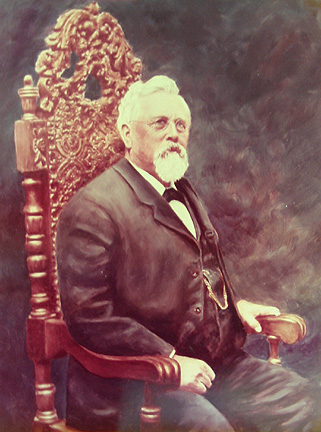
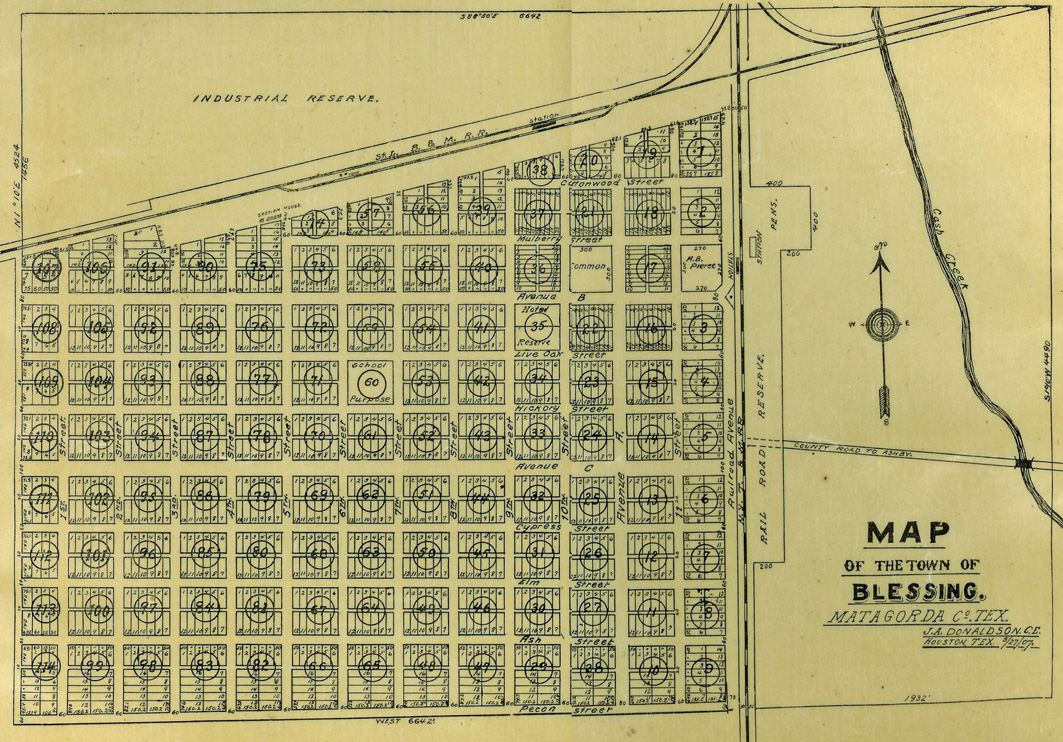
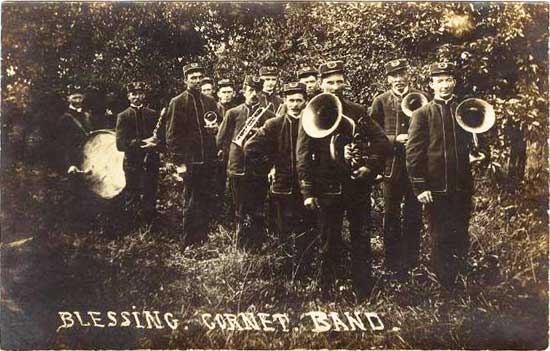 Gibson
Gibson 